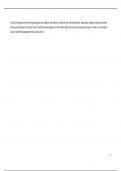Samenvatting
Sport psychology samenvatting Radboud SOW-PSB3BE20E
- Vak
- Instelling
- Boek
In deze volledige samenvatting wordt de stof van Sport Psychology SOW-PSB3BE20E samengevat. De samenvatting bevat zowel stof van het boek, de artikelen en aantekeningen van de colleges. Verder bevat hij ook afbeeldingen. De samenvatting is in het Engels geschreven. In this complete summary, the ...
[Meer zien]













